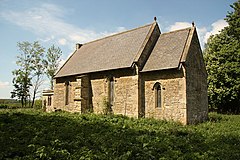| Caenby | |
|---|---|
 The grade II listed St.Nicholas' church in Caenby | |
Location within
Lincolnshire | |
| OS grid reference | TF001893 |
| • London | 130 mi (210 km) S |
| District | |
| Shire county | |
| Region | |
| Country | England |
| Sovereign state | United Kingdom |
| Post town | Market Rasen |
| Postcode district | LN8 |
| Police | Lincolnshire |
| Fire | Lincolnshire |
| Ambulance | East Midlands |
| UK Parliament | |
Caenby is a hamlet and civil parish in the West Lindsey district of Lincolnshire, England. It is situated 10 miles (16 km) north of the city and county town of Lincoln. The population is included in the civil parish of Glentham.
The place name, Caenby, seems to contain an unrecorded Old Norse personal name Kafni, + bȳ (Old Norse), a farmstead, a village, so possibly, 'Kafni's farm or settlement'. [1] The place appears in the Domesday Book of 1086 as Couenebi. [2]
Caenby's Grade II listed Anglican church is dedicated to St Nicholas. [3] A moated manor house, now the Grade II listed Hall Farm House, [4] was a seat of the Tournay family from the time of Edward I to George II. In 1541 Henry VIII slept here while on his Lincolnshire progress. [5] In the 18th century, Lawrence Monck occupied the house. [4] [6]
In 1945 fields adjacent to Caenby were a military Q decoy site maintained by RAF Hemswell. Dummy plywood buildings, inflatable rubber aircraft or vehicles, and a ploughed faux runway were set up to simulate an active airfield and draw German bombers away from genuine target airfields. [7]
- ^ A. D. Mills, Dictionary of English Place-Names (Oxford, 2002), p. 92; E. Ekwall, Concise Oxford Dictionary of English Place-names (Oxford, 1960), p. 81; K. Cameron, Dictionary of Lincolnshire place-names, (Nottingham, 1998), p. 26; K. Cameron (ed.), Place Names of Lincolnshire: Part 6 (Nottm, 2001), p. 137
- ^ National Archives: E31/2/2/7059
- ^ Historic England. "Church of St Nicholas (1317511)". National Heritage List for England. Retrieved 10 July 2011.
- ^ a b Historic England. "Hall Farm House (1064182)". National Heritage List for England. Retrieved 10 July 2011.
- ^ Cox, J. Charles (1916) Lincolnshire p. 92; Methuen & Co. Ltd
- ^ Hodgson, John A History of Northumberland, in three parts, Part 2, Volume 1 p. 356. (2010), ISBN 1-145-53854-1. Retrieved 10 July 2011
- ^ Philip Ralph Johnston (5 December 2012). "Caenby Q Site". raf-lincolnshire.info. Retrieved 6 July 2023.
-
 Media related to
Caenby at Wikimedia Commons
Media related to
Caenby at Wikimedia Commons - "Caenby (or Cannby)", Genuki.org.uk. Retrieved 10 July 2011
| Caenby | |
|---|---|
 The grade II listed St.Nicholas' church in Caenby | |
Location within
Lincolnshire | |
| OS grid reference | TF001893 |
| • London | 130 mi (210 km) S |
| District | |
| Shire county | |
| Region | |
| Country | England |
| Sovereign state | United Kingdom |
| Post town | Market Rasen |
| Postcode district | LN8 |
| Police | Lincolnshire |
| Fire | Lincolnshire |
| Ambulance | East Midlands |
| UK Parliament | |
Caenby is a hamlet and civil parish in the West Lindsey district of Lincolnshire, England. It is situated 10 miles (16 km) north of the city and county town of Lincoln. The population is included in the civil parish of Glentham.
The place name, Caenby, seems to contain an unrecorded Old Norse personal name Kafni, + bȳ (Old Norse), a farmstead, a village, so possibly, 'Kafni's farm or settlement'. [1] The place appears in the Domesday Book of 1086 as Couenebi. [2]
Caenby's Grade II listed Anglican church is dedicated to St Nicholas. [3] A moated manor house, now the Grade II listed Hall Farm House, [4] was a seat of the Tournay family from the time of Edward I to George II. In 1541 Henry VIII slept here while on his Lincolnshire progress. [5] In the 18th century, Lawrence Monck occupied the house. [4] [6]
In 1945 fields adjacent to Caenby were a military Q decoy site maintained by RAF Hemswell. Dummy plywood buildings, inflatable rubber aircraft or vehicles, and a ploughed faux runway were set up to simulate an active airfield and draw German bombers away from genuine target airfields. [7]
- ^ A. D. Mills, Dictionary of English Place-Names (Oxford, 2002), p. 92; E. Ekwall, Concise Oxford Dictionary of English Place-names (Oxford, 1960), p. 81; K. Cameron, Dictionary of Lincolnshire place-names, (Nottingham, 1998), p. 26; K. Cameron (ed.), Place Names of Lincolnshire: Part 6 (Nottm, 2001), p. 137
- ^ National Archives: E31/2/2/7059
- ^ Historic England. "Church of St Nicholas (1317511)". National Heritage List for England. Retrieved 10 July 2011.
- ^ a b Historic England. "Hall Farm House (1064182)". National Heritage List for England. Retrieved 10 July 2011.
- ^ Cox, J. Charles (1916) Lincolnshire p. 92; Methuen & Co. Ltd
- ^ Hodgson, John A History of Northumberland, in three parts, Part 2, Volume 1 p. 356. (2010), ISBN 1-145-53854-1. Retrieved 10 July 2011
- ^ Philip Ralph Johnston (5 December 2012). "Caenby Q Site". raf-lincolnshire.info. Retrieved 6 July 2023.
-
 Media related to
Caenby at Wikimedia Commons
Media related to
Caenby at Wikimedia Commons - "Caenby (or Cannby)", Genuki.org.uk. Retrieved 10 July 2011
